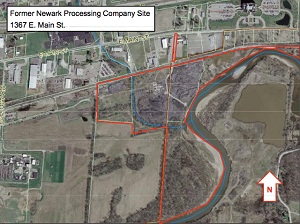Newark, Ohio, to power city buildings with solar on brownfield
 In a bid to revitalize the city of Newark, Ohio, the city is considering installing a photovoltaic array over a blighted brownfield. It will issue a request for proposals (RFP) in the coming weeks to install solar on up to a 40-acre section of the brownfield to power city buildings.
In a bid to revitalize the city of Newark, Ohio, the city is considering installing a photovoltaic array over a blighted brownfield. It will issue a request for proposals (RFP) in the coming weeks to install solar on up to a 40-acre section of the brownfield to power city buildings.
The former Newark Processing Co. aluminum dross extraction plant produced aluminum dross waste as a byproduct of the extraction process. The company began operations in 1980 at the site and went bankrupt in 1996.
The site is currently being capped, thanks to a $2 million Clean Ohio Revitalization Fund grant, said Stuart Moynihan, Newark’s economic development coordinator. The work on the cap is slated for completion by the end of 2011.
The U.S. EPA and the Army Corps of Engineers also spent $2.5 million to stabilize the site’s border with the Licked River. “That was done years back,” Moynihan said.
Both steps are intended to contain contamination at the site and prevent it from entering the groundwater.
“Being a brownfield site, it’s not developable as a building site,” Moynihan said. “We’d like to do something for the city with it.”
The city plans to issue an RFP for the site in the coming weeks, according to Moynihan. As such, he’s not yet sure what size a system the city will consider for the site. But The Columbus Dispatch reported that the array could cover between 24 acres to 40 acres of land.
The RFP will likely be for a power-purchase agreement for an array, allowing the city to buy the power produced at a set rate rather than paying for the system outright. The power produced at the site will only be for city use, according to Moynihan. Any excess power produced will be sold back to the grid, he said.
An important component of the likely RFP will be a local jobs component. Unemployment in Ohio and Newark is higher than the national average, Moynihan said.
“We’re going to try to use this to create as many local jobs as possible. As much as possible, we’ll use Ohio products and products made in the U.S.A., and use Ohio workers,” he said.



